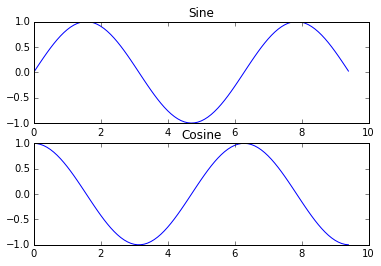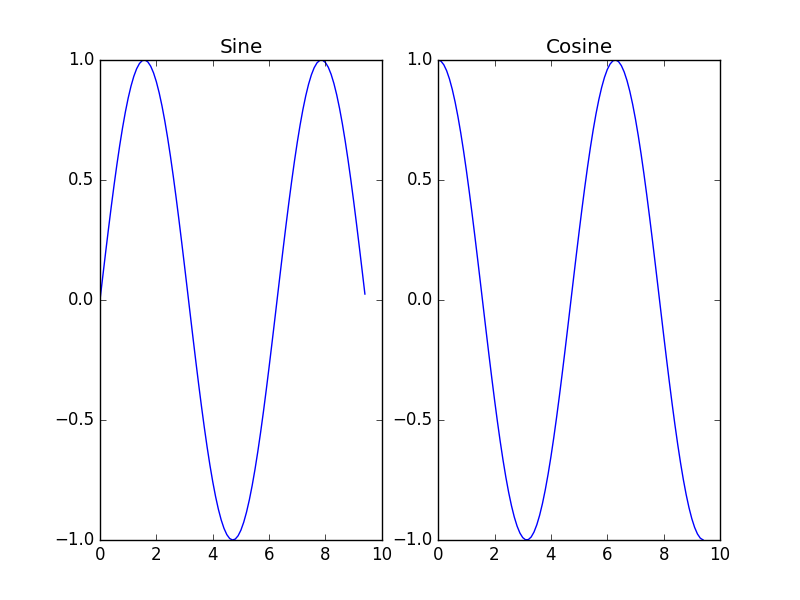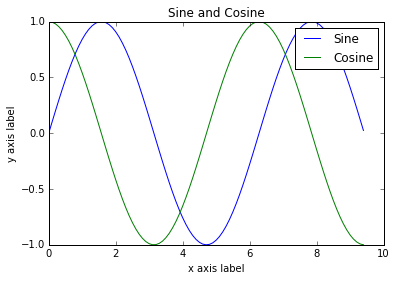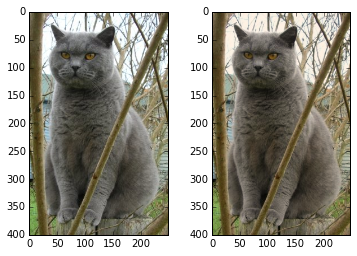翻译:Python Numpy教程。
-----------------------------------------------------------------------------------------
cs231n课程中的python快速入门
以下为阿幻的学习笔记:
Python
Table of contents:
python
- Basic data types
- Containers(容器)
- lists
- dictionaries
- sets(集合)
- tuples(元组)
- Functions
- Classes
Numpy
- Arrays
- Array indexing(访问数组)
- Datatypes
- Array math
- Broadcasting(广播?)
SciPy
- image operations
- MATLAB files
- Distance between points
Matplotlib
- Potting(绘图)
- Subplots(绘制多个图形)
- Images
^^^^^^^^^^^^^^^^^^^^^^^^^^^^^^^^^^^^^^^^^^^^^^^^^^^^^^^^^^^^^^^^^^^^^^^^^^
介儿个 上边是 目录
介儿个 下边是 我的笔记
vvvvvvvvvvvvvvvvvvvvvvvvvvvvvvvvvvvvvvvvvvvvvvvvvvvvvvvvvvvvvvvvvvvvvv
python
- Basic data types
1. n次方 **n (介个我以前不知道)
2. python中没有 x++ 或 x-- 操作
3. python中没有 && 和 || ,用and,or,not,!=
4. 字符串操作
s = "hello" print(len(s)) #print 5 print(s.capitalize()) # Capitalize a string; prints "Hello" print(s.upper()) # Convert a string to uppercase; prints "HELLO" print(s.rjust(7)) # Right-justify a string, padding with spaces; prints " hello" print(s.center(7)) # Center a string, padding with spaces; prints " hello " print(s.replace('l', '(ell)')) # Replace all instances of one substring with another; # prints "he(ell)(ell)o" print(' world '.strip()) # Strip leading and trailing whitespace; prints "world"
- Containers(容器)
- lists
5. 末尾的添加和删除, 以及slicing(切片)操作
xs = [3, 1, 2] # Create a list print(xs[-1]) # Negative indices count from the end of the list; prints "2" xs[2] = 'foo' # Lists can contain elements of different types print(xs) # Prints "[3, 1, 'foo']" xs.append('bar') # Add a new element to the end of the list print(xs) # Prints "[3, 1, 'foo', 'bar']" x = xs.pop() # Remove and return the last element of the list print(x, xs) # Prints "bar [3, 1, 'foo']" print(xs[1:]) # Prints "[1, 'foo']" slicing(切片)
6. 想要在循环体内访问每个元素的指针,可以使用内置的enumerate函数
animals = ['cat', 'dog', 'monkey'] for idx, animal in enumerate(animals): print '#%d: %s' % (idx + 1, animal) # Prints "#1: cat", "#2: dog", "#3: monkey", each on its own line
7. 列表推导List comprehensions:在编程的时候,我们常常想要将一种数据类型转换为另一种。下面是一个简单例子,将列表中的每个元素变成它的平方。
nums = [0, 1, 2, 3, 4] squares = [x ** 2 for x in numsif x % 2 == 0]
print squares # Prints [0, 4, 16]
- dictionaries
8. 字典用来储存(键, 值)对,想要访问键和对应的值,那就使用iteritems方法:
d = {'person': 2, 'cat': 4, 'spider': 8}
for animal, legs in d.iteritems():
print 'A %s has %d legs' % (animal, legs)
# Prints "A person has 2 legs", "A spider has 8 legs", "A cat has 4 legs"
字典推导Dictionary comprehensions:和列表推导类似,但是允许你方便地构建字典。
- sets(集合)
9. 集合是独立不同个体的无序集合
animals = {'cat', 'dog'}
animals.add('fish') # Add an element to a set
animals.remove('cat') # Remove an element from a set
在集合中循环的语法和在列表中一样,但是集合是无序的,所以你在访问集合的元素的时候,不能做关于顺序的假设。
集合推导Set comprehensions:和字典推导一样,可以很方便地构建集合:
- tuples(元组)
10. 元组是一个值的有序列表(不可改变)。从很多方面来说,元组和列表都很相似。和列表最重要的不同在于,元组可以在字典中用作键,还可以作为集合的元素,而列表不行。
d = {(x, x + 1): x for x in range(10)} # Create a dictionary with tuple keys
print d
t = (5, 6) # Create a tuple
print type(t) # Prints "<type 'tuple'>"
print d[t] # Prints "5"
print d[(1, 2)] # Prints "1"
- Functions
11. Python函数使用def来定义函数
- Classes
12. Python对于类的定义是简单直接的:
class Greeter(object): # Constructor def __init__(self, name): self.name = name # Create an instance variable # Instance method def greet(self, loud=False): if loud: print 'HELLO, %s!' % self.name.upper() else: print 'Hello, %s' % self.name g = Greeter('Fred') # Construct an instance of the Greeter class g.greet() # Call an instance method; prints "Hello, Fred" g.greet(loud=True) # Call an instance method; prints "HELLO, FRED!"
Numpy
Numpy是Python中用于科学计算的核心库。它提供了高性能的多维数组对象,以及相关工具。
- Arrays
13. 一个numpy数组是一个由不同数值组成的网格。网格中的数据都是同一种数据类型,可以通过非负整型数的元组来访问。维度的数量被称为数组的阶,数组的大小是一个由整型数构成的元组,可以描述数组不同维度上的大小。
import numpy as np b = np.array([[1,2,3],[4,5,6]]) # Create a rank 2 array print b # 显示一下矩阵b print b.shape # Prints "(2, 3)" print b[0, 0], b[0, 1], b[1, 0] # Prints "1 2 4" a = np.zeros((2,2)) # Create an array of all zeros print a # Prints "[[ 0. 0.] # [ 0. 0.]]"
b = np.ones((1,2)) # Create an array of all ones print b # Prints "[[ 1. 1.]]"
c = np.full((1,2), 7) # Create a constant array
d = np.eye(3) # Create a 2x2 identity matrix print d # Prints "[[ 1. 0. 0.] # [ 0. 1. 0.]
# [ 0. 0. 1.]]"
e = np.random.random((2,2)) # Create an array filled with random values
print e # Might print "[[ 0.91940167 0.08143941]
# [ 0.68744134 0.87236687]]"
- Array indexing(访问数组)
14. 整形数组访问 布尔型数组访问
切片: 必须为每个维度指定好切片。
import numpy as np # Create the following rank 2 array with shape (3, 4) # [[ 1 2 3 4] # [ 5 6 7 8] # [ 9 10 11 12]] a = np.array([[1,2,3,4], [5,6,7,8], [9,10,11,12]]) # Use slicing to pull out the subarray consisting of the first 2 rows # and columns 1 and 2; b is the following array of shape (2, 2): # [[2 3] # [6 7]] b = a[:2, 1:3] # A slice of an array is a view into the same data, so modifying it # will modify the original array. print a[0, 1] # Prints "2" b[0, 0] = 77 # b[0, 0] is the same piece of data as a[0, 1] print a[0, 1] # Prints "77"
print a[a>10] # Print [11,12]
整型数组访问语法还有个有用的技巧,可以用来选择或者更改矩阵中每行中的一个元素:
import numpy as np # Create a new array from which we will select elements a = np.array([[1,2,3], [4,5,6], [7,8,9], [10, 11, 12]]) print a # prints "array([[ 1, 2, 3], # [ 4, 5, 6], # [ 7, 8, 9], # [10, 11, 12]])" # Create an array of indices b = np.array([0, 2, 0, 1]) # Select one element from each row of a using the indices in b print a[np.arange(4), b] # Prints "[ 1 6 7 11]" # Mutate one element from each row of a using the indices in b a[np.arange(4), b] += 10 print a # prints "array([[11, 2, 3], # [ 4, 5, 16], # [17, 8, 9], # [10, 21, 12]])
- Datatypes
每个Numpy数组都是数据类型相同的元素组成的网格。Numpy提供了很多的数据类型用于创建数组。当你创建数组的时候,Numpy会尝试猜测数组的数据类型,你也可以通过参数直接指定数据类型
- Array math
基本数学计算函数会对数组中元素逐个进行计算,既可以利用操作符重载,也可以使用函数方式:
import numpy as np x = np.array([[1,2],[3,4]], dtype=np.float64) y = np.array([[5,6],[7,8]], dtype=np.float64) # Elementwise sum; both produce the array # [[ 6.0 8.0] # [10.0 12.0]] print x + y print np.add(x, y) # Elementwise difference; both produce the array # [[-4.0 -4.0] # [-4.0 -4.0]] print x - y print np.subtract(x, y) # Elementwise product; both produce the array # [[ 5.0 12.0] # [21.0 32.0]] print x * y print np.multiply(x, y) # Elementwise division; both produce the array # [[ 0.2 0.33333333] # [ 0.42857143 0.5 ]] print x / y print np.divide(x, y) # Elementwise square root; produces the array # [[ 1. 1.41421356] # [ 1.73205081 2. ]] print np.sqrt(x)
*是元素逐个相乘,而不是矩阵乘法。在Numpy中使用dot来进行矩阵乘法:
# Matrix / matrix product; both produce the rank 2 array # [[19. 22.] # [43. 50.]] print x.dot(y) print np.dot(x, y)
sum函数
import numpy as np x = np.array([[1,2],[3,4]]) print np.sum(x) # Compute sum of all elements; prints "10" print np.sum(x, axis=0) # Compute sum of each column; prints "[4 6]" print np.sum(x, axis=1) # Compute sum of each row; prints "[3 7]"
在Numpy中,使用T来转置矩阵:
import numpy as np x = np.array([[1,2], [3,4]]) print x # Prints "[[1 2] # [3 4]]" print x.T # Prints "[[1 3] # [2 4]]" # Note that taking the transpose of a rank 1 array does nothing: v = np.array([1,2,3]) print v # Prints "[1 2 3]" print v.T # Prints "[1 2 3]"
- Broadcasting(广播?)
一种强有力的机制,它让Numpy可以让不同大小的矩阵在一起进行数学计算. 支持广播机制的函数是全局函数。
举个例子,如果我们要把一个向量加到矩阵的每一行:
import numpy as np # We will add the vector v to each row of the matrix x, # storing the result in the matrix y x = np.array([[1,2,3], [4,5,6], [7,8,9], [10, 11, 12]]) v = np.array([1, 0, 1]) y = x + v # Add v to each row of x using broadcasting print y # Prints "[[ 2 2 4] # [ 5 5 7] # [ 8 8 10] # [11 11 13]]"
对两个数组使用广播机制要遵守下列规则:
- 如果数组的秩不同,使用1来将秩较小的数组进行扩展,直到两个数组的尺寸的长度都一样。
- 如果两个数组在某个维度上的长度是一样的,或者其中一个数组在该维度上长度为1,那么我们就说这两个数组在该维度上是相容的。
- 如果两个数组在所有维度上都是相容的,他们就能使用广播。
- 如果两个输入数组的尺寸不同,那么注意其中较大的那个尺寸。因为广播之后,两个数组的尺寸将和那个较大的尺寸一样。
- 在任何一个维度上,如果一个数组的长度为1,另一个数组长度大于1,那么在该维度上,就好像是对第一个数组进行了复制。
import numpy as np # Compute outer product of vectors v = np.array([1,2,3]) # v has shape (3,) w = np.array([4,5]) # w has shape (2,) # To compute an outer product, we first reshape v to be a column # vector of shape (3, 1); we can then broadcast it against w to yield # an output of shape (3, 2), which is the outer product of v and w: # [[ 4 5] # [ 8 10] # [12 15]] print np.reshape(v, (3, 1)) * w # Add a vector to each row of a matrix x = np.array([[1,2,3], [4,5,6]]) # x has shape (2, 3) and v has shape (3,) so they broadcast to (2, 3), # giving the following matrix: # [[2 4 6] # [5 7 9]] print x + v # Add a vector to each column of a matrix # x has shape (2, 3) and w has shape (2,). # If we transpose x then it has shape (3, 2) and can be broadcast # against w to yield a result of shape (3, 2); transposing this result # yields the final result of shape (2, 3) which is the matrix x with # the vector w added to each column. Gives the following matrix: # [[ 5 6 7] # [ 9 10 11]] print (x.T + w).T # Another solution is to reshape w to be a row vector of shape (2, 1); # we can then broadcast it directly against x to produce the same # output. print x + np.reshape(w, (2, 1)) # Multiply a matrix by a constant: # x has shape (2, 3). Numpy treats scalars as arrays of shape (); # these can be broadcast together to shape (2, 3), producing the # following array: # [[ 2 4 6] # [ 8 10 12]] print x * 2
SciPy(提供了一些操作图像的基本函数。)
- image operations
熟悉SciPy的最好方法就是阅读文档。
from scipy.misc import imread, imsave, imresize, imshow # Read an JPEG image into a numpy array img = imread('1.jpg') print img.dtype, img.shape # Prints "uint8 (400, 248, 3)" # We can tint the image by scaling each of the color channels # by a different scalar constant. The image has shape (400, 248, 3); # we multiply it by the array [1, 0.95, 0.9] of shape (3,); # numpy broadcasting means that this leaves the red channel unchanged, # and multiplies the green and blue channels by 0.95 and 0.9 # respectively.
img_tinted = img * [1, 0, 0] #处理RGB颜色通道
# Resize the tinted image to be 300 by 300 pixels. img_tinted = imresize(img_tinted, (300, 300))
# Write the tinted image back to disk imsave('assets/cat_tinted.jpg', img_tinted)
- MATLAB files
函数scipy.io.loadmat和scipy.io.savemat能够让你读和写MATLAB文件。具体请查看文档。
- Distance between points
函数scipy.spatial.distance.pdist能够计算集合中所有两点之间的距离:
import numpy as np from scipy.spatial.distance import pdist, squareform # Create the following array where each row is a point in 2D space: # [[0 1] # [1 0] # [2 0]] x = np.array([[0, 1], [1, 0], [2, 0]]) print x # Compute the Euclidean distance between all rows of x. # d[i, j] is the Euclidean distance between x[i, :] and x[j, :], # and d is the following array: # [[ 0. 1.41421356 2.23606798] # [ 1.41421356 0. 1. ] # [ 2.23606798 1. 0. ]] d = squareform(pdist(x, 'euclidean'))
pdist(x, 'euclidean') # array([ 1.41421356, 2.23606798, 1. ])
Matplotlib
Matplotlib是一个作图库。这里简要介绍matplotlib.pyplot模块,功能和MATLAB的作图功能类似。
- Potting(绘图)
matplotlib库中最重要的函数是Plot。该函数允许你做出2D图形,如下:
import numpy as np import matplotlib.pyplot as plt # Compute the x and y coordinates for points on sine and cosine curves x = np.arange(0, 3 * np.pi, 0.1) y_sin = np.sin(x) y_cos = np.cos(x) # Plot the points using matplotlib plt.plot(x, y_sin) plt.plot(x, y_cos) plt.xlabel('x axis label') plt.ylabel('y axis label') plt.title('Sine and Cosine') plt.legend(['Sine', 'Cosine']) plt.show()
- Subplots(绘制多个图形)
可以使用subplot函数来在一幅图中画不同的东西:
import numpy as np import matplotlib.pyplot as plt # Compute the x and y coordinates for points on sine and cosine curves x = np.arange(0, 3 * np.pi, 0.1) y_sin = np.sin(x) y_cos = np.cos(x) # Set up a subplot grid that has height 2 and width 1, # and set the first such subplot as active. plt.subplot(2, 1, 1) # Make the first plot plt.plot(x, y_sin) plt.title('Sine') # Set the second subplot as active, and make the second plot. plt.subplot(2, 1, 2) plt.plot(x, y_cos) plt.title('Cosine')###(plt.subplot(2, 1, *) ) ###(plt.subplot( 1, 2, *) )


- Images
可使用imshow函数来显示图像
import numpy as np from scipy.misc import imread, imresize import matplotlib.pyplot as plt img = imread('assets/cat.jpg') img_tinted = img * [1, 0.95, 0.9] # Show the original image plt.subplot(1, 2, 1) plt.imshow(img) # Show the tinted image plt.subplot(1, 2, 2) # A slight gotcha with imshow is that it might give strange results # if presented with data that is not uint8. To work around this, we # explicitly cast the image to uint8 before displaying it. plt.imshow(np.uint8(img_tinted)) plt.show()





